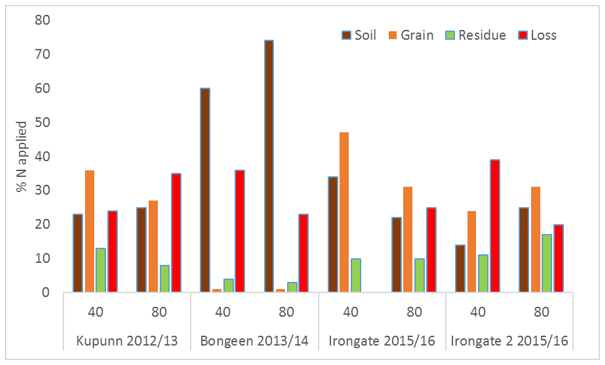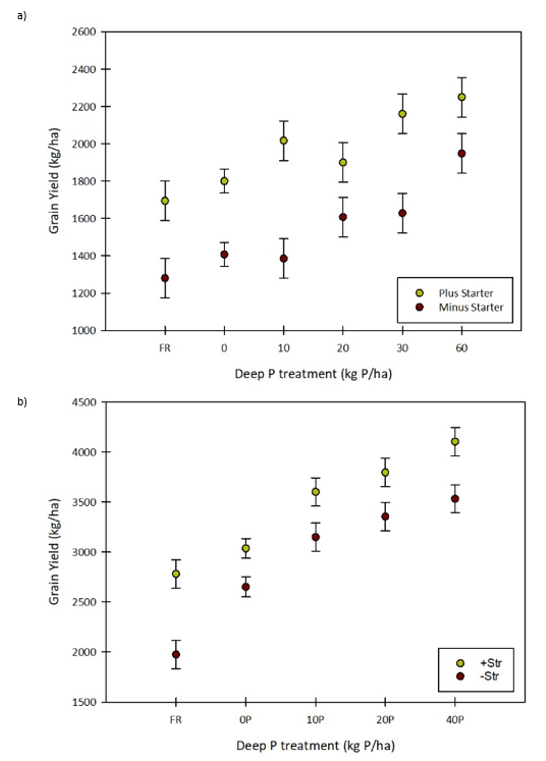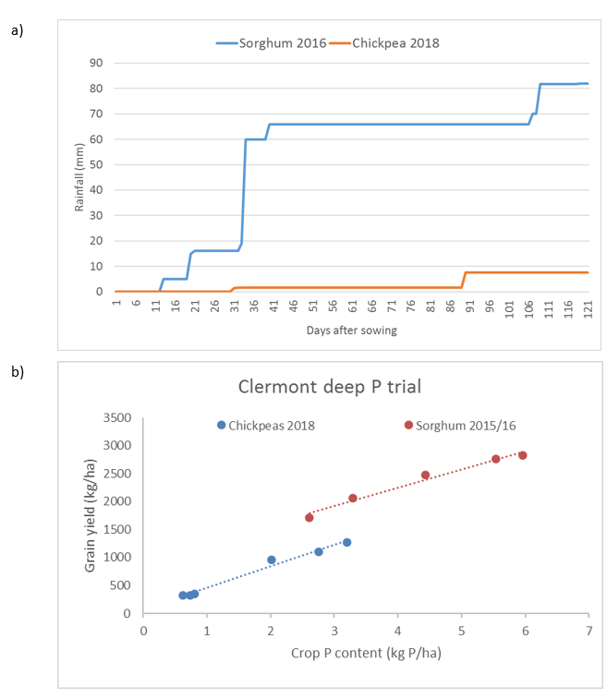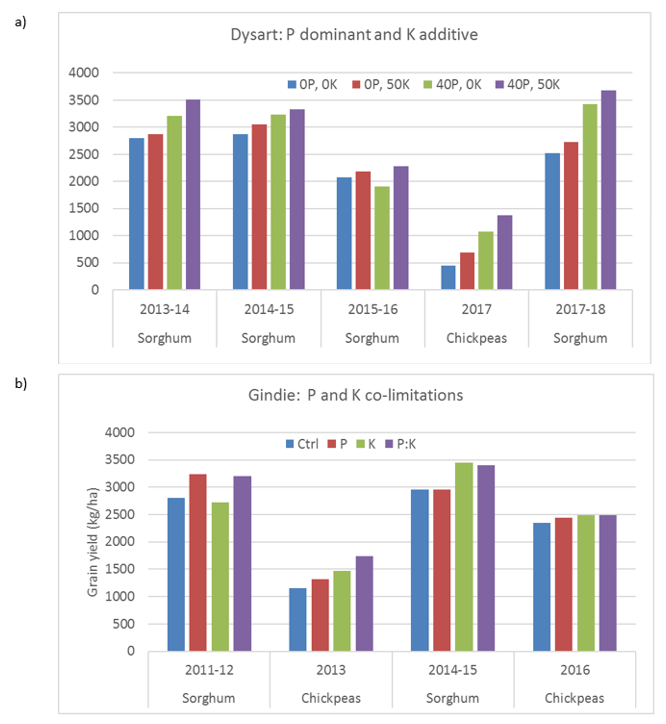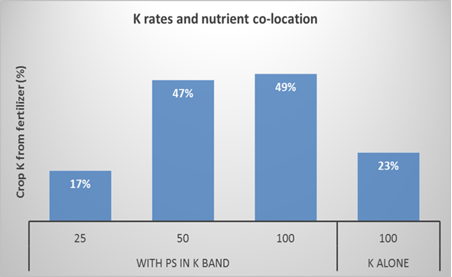Nutritional strategies to support productive farming systems
Author: Michael Bell (University of Queensland Gatton Campus), David Lester (Department of Agriculture and Forestry, Toowoomba) and Doug Sands (Department of Agriculture and Forestry, Emerald) | Date: 23 Jul 2020
Take home messages
- A critical success factor for cropping systems that rely heavily on stored soil water is co-location of plant nutrients with moist soil and active roots
- Our current fertiliser management practices need refinement, with low efficiency of fertiliser recovery often associated with nutrients and water being in different parts of the soil profile
- There needs to be greater consideration of placement and timing of fertiliser applications to improve fertiliser nutrient recovery
- Declining native fertility reserves means more complex fertiliser combinations will be needed to meet crop demands
Introduction
This paper is based on a series of observations made in recent years from the projects listed above, as well as others made by Richard Daniel and the NGA team in their work on fertiliser N application strategies for winter crops. Collectively, the findings from this research, backed by the underlying regional trends in soil fertility and the drivers for successful rainfed cropping in our region, provide some useful insights into what are likely to be the critical success factors for future fertiliser management programs.
Do we have successful fertility management systems?
To maximise the chance of achieving effective use of available moisture, an effective fertiliser management strategy needs to consider all of the 4R’s (right product, in the right place, at the right time and at the right rate – Johnson and Bruulsema 2014). While everyone pays lip service to these 4R’s, our real thinking is often driven by considerations about only one – rate. We spend a lot of time agonising over rate, because rate is clearly an important part of the economics of growing the crop. Rate is also an important consideration in terms of soil fertility maintenance (ie. replacing what we remove in grain). In many cases the rate we can afford is not always the rate we need to apply to optimise productivity, much less balance nutrient removal, but we still spend a lot of time thinking about it.
Because of that, we find that the thinking about the other 3R’s tends to be much more superficial. Occasionally we might have a try at something a bit different, but in many cases we tend to keep doing what we have always done, and put the same products in the same place at the same time each year. Meanwhile, our background soil fertility reserves have fallen and our crops are becoming increasingly reliant on off-farm sources of fertility (fertilisers, manures etc.) to sustain productivity. It is this increasing reliance on fertilisers, especially N, P and (increasingly) K, that is allowing us to really see the inefficiency in current use practices. The impact of these inefficiencies in terms of lost productivity can often dwarf any of the considerations of rate, and are highlighting challenges for productivity and profitability in the long term.
We will now cover some examples of inefficiencies that are apparent in what has been considered as best practice for both N and P, and how the emergence of K infertility is adding further complexity to fertiliser best practice.
Management of fertiliser N
In the case of N in winter cereals, the recent comprehensive analysis of a series of N experiments from 2014-2017 by Daniel et al. (2018) highlighted the poor winter crop recovery of fertiliser N applied in the traditional application window (the months leading up to sowing, or at sowing itself). Fertiliser N recovered in grain averaged only 15% for applications of 50 kg N/ha and 9% for 100 kg N/ha. On average, 65% of the applied N was still in the soil as mineral N at the end of the crop season, while an only 15% was in the crop (grain and stubble). The fate of the other 20% of applied N could not be determined. Some of the soil and stubble N will carry over until the next season, but it means that you need last year’s residual fertiliser to get you through this year. If you had a big year last year (little residual N) or lost a lot of the N carryover during a wet season, the current crop will suffer.
The poor winter crop recovery of applied N in the year of application mirrored that reported for summer sorghum in the NANORP research program reported by Bell, Schwenke and Lester (2016), with the use of 15N tracers enabling a more precise quantification of the fate of N applied prior to planting. Data from the Queensland sites in commercial fields are shown in Figure 1 for the 40 and 80 kg N rates across three growing seasons. Fertiliser N in grain averaged 27% and 23% of the applied N for the 40 and 80N rates, respectively, while total crop uptake averaged only 37% and 32% for the same N rates. What is noticeable in this figure is the variable N losses (presumably via denitrification) and the residual N in the soil, which may or may not be available for a subsequent crop in the rotation, depending on the fallow conditions. Schwenke and Haig (2019) reported good carryover of fertiliser applied for the 2013/14 sorghum crop for recovery by the 2014/15 season under favourable fallow conditions, while extensive loss of residual soil N after summer crops was experienced over large areas during the wet 2016 winter fallow.
Figure 1. Partitioning of fertiliser N between soil, plant and environmental loss pools for summer sorghum crops grown on the Darling Downs in UQ00066 from 2012-2016
All studies have shown there can be significant amounts of residual N in the soil at the end of the growing season. Large amounts of that N are often found in quite shallow parts of the soil profile (ie. the 0-10 cm and possibly 10-20 cm layers) and still strongly centred on the fertiliser bands, despite what were often significant falls of rain in-crop (ie. 200-300 mm). Even after a subsequent fallow, the Daniel et al. (2018) paper reported that 50-60% of the mineral N residual from fertiliser applied in the previous season was still in the top 45 cm, with as much as half of this still in the 0-15 cm layer. This largely surface-stratified residual N would have contributed to the quite muted (although still significant) grain yield response to the residual N in those studies.
Interestingly, findings from both the summer sorghum and winter cereal research suggest that crops recover mineral N that is distributed through the soil profile with much greater efficiency than fertiliser applied at or near sowing. In both seasons, 70-80% of the mineral N in the soil profile was recovered in the crop biomass, compared to recoveries of applied fertiliser that were commonly less than half that. The distribution of that N relative to soil water is likely to have played a major role in this greater recovery efficiency.
Management of fertiliser P
The substantial responses to deep P bands across the northern region where subsoil P is low have been detailed in a number of recent publications (Lester et al. 2019b, Sands et al. 2018), with these responses typically additive to any responses to starter P fertiliser (the traditional P fertiliser application method – eg. Figure 2a,b). There has unfortunately been no direct measurement of P unequivocally taken from either deep or starter P bands due to the lack of suitable tracer technology, especially when we consider residual benefits over 4-5 years. However, simple differences in biomass P uptake in a single season suggest that the quantum of P accumulated from deep bands (3-5 kg P/ha) is substantially greater than that from starter P alone (1-1.5 kg P/ha) in all bar exceptionally dry seasons.
Figure 2. Response to different rates of deep P with and without applications of starter P fertiliser in (a) a wheat crop at Condamine in 2018 wheat, and (b) a sorghum crop at Dysart in 2018/19 grain yield for deep-placed P treatments (kg P/ha) with or without starter application. The vertical bars represent the standard error for each mean. (Lester et al. 2019a)
Perhaps one of the most significant findings from the deep P research has been the relative consistency of P acquisition from deep bands, despite significant variability in seasonal conditions. Research results from sites in Central Qld (CQ) often provide the best examples of this, due to the extremely low subsoil P reserves in some of those situations – if the crop cannot access the deep P bands, there is not much to find anywhere else in the subsoil! Interestingly, this type of profile P distribution is consistent with the lack of grain yield responses to starter P that were recorded over a number of years of trials in CQ and that contributed to reluctance to use starter P in some situations. Early growth responses that were consistent with the crop obtaining an extra 1-1.5 kg P/ha from the starter application were observed, but a lack of available profile P to grow biomass and fill grains limited any resulting yield responses.
The inability to acquire P from a depleted subsoil places greater importance on access to P in the topsoil, which means that seasonal rainfall distribution can have a huge impact on crop P status. This is illustrated for a site near Clermont in Figure 3 (a, b), in which the growing season conditions and crop P acquisition by successive crops of sorghum and chickpea are compared. From a yield perspective, deep P increased crop yield by 1100 kg and 960 kg for the sorghum and chickpea crops, relative to the untreated Farmer Reference treatment, and by 720 kg and 970 kg/ha for the same crops relative to the 0P treatment that received ripping and other background nutrients. The similar size of yield responses in the two crops represented quite different relative yield increases (40-60% in the sorghum, versus about 300% in the chickpeas), and obviously had hugely different impacts economically, given the price differential between sorghum and chickpea grain. However, from a nutrient use efficiency perspective it is interesting to note that the apparent P acquisition from the deep P bands was similar (3.3 kg P/ha in the sorghum and 2.7 kg P/ha in the chickpeas - Figure 3b)) despite the vastly different in-season rainfall (Figure 3a).
What is dramatically different, and what is driving the much larger relative yield response in the chickpea crop, was the inability to access P without deep P bands in that growing season. Crop P contents in the Farmer Reference and 0 P treatments averaged 2.9 kg P/ha in the sorghum crop but only 0.6 kg P/ha in the chickpeas. This difference was driven by the combination of deep sowing and extremely dry topsoils encountered in the 2018 winter season. The chickpea crop was planted below the 0-10 cm layer, and there was never enough in-season rainfall to encourage later root growth and P recovery from that layer. Despite available moisture in the subsoil, there was not much P available to support growth and yield. In contrast, the sorghum crop was planted into the relatively P-rich top 10 cm layer, which was then rewet regularly over a significant proportion of the vegetative phase. This allowed better P acquisition from the background soil, but the deep P bands were still able to supplement this and provide an additional yield benefit.
Figure 3. (a) Cumulative in-crop rainfall and (b) the relationship between crop P content and grain yield for consecutive crops of sorghum (2015/16) and chickpea (2018) grown at a site near Clermont, in Central Queensland (Sands et al., 2019)
Choice of product to address multiple nutrient limitations
As native fertility has been eroded by negative nutrient budgets and/or inappropriate placement, there are an increasing number of instances of complex nutrient limitations that require compound fertilisers to address multiple constraints, with the relative severity of each constraint changing from season to season. Perhaps the best example has been the emergence of widespread examples of K deficiency in recent (drier) seasons, but which can ‘disappear’ in more favourable ones. This is an example of the impact of increasingly depleted and more stratified K reserves, and is an issue that adds complexity to fertility management programs. Soil testing benchmarks for subsoil nutrients are improving as a result of current programs, but at best they are only likely to ring alarm bells for the different constraints, rather than predict the relative importance of each in future (uncertain) seasonal conditions. Examples provided in Figure 4, again from sites in CQ, show fields where subsoil P and K would both be considered limiting to productivity, but the responses to deep placed P and K have varied with crop and seasonal conditions. Assuming enough N is applied, the site at Dysart shows a dominant P constraint which is evident in most seasons, and a smaller K limitation that is only visible once the P constraint has been overcome. The Gindie site, on the other hand, has limitations of both P and K, but the relative importance of each constraint seems to depend on the crop choice and/or seasonal conditions. In both cases, the appropriate agronomic response would be to apply both nutrients, but the relative economic returns of adding K to the fertiliser program (as opposed to higher/more frequent P additions) would be different.
The emergence of multiple constraints such as those shown in Figure 4 require a greater understanding of the implications of co-location of different products, especially in concentrated bands applied at high(er) rates, less frequently. There is evidence that effective utilisation of banded K, at least in Vertosols, is dependent on co-location with a nutrient like P to encourage root proliferation around the K source (Figure 5 - Bell et al., 2017). However, there is also evidence that there can be negative interactions between P and K applied together in concentrated bands that can reduce the availability of both nutrients. There is an existing investment (UOQ1706-006RTX) exploring the reactions that occur in bands containing N, P and K, and the implications of changing the products and the in-band concentrations on nutrient availability. Current findings suggest that more acidic the band the more likely there will be reduced P availability, which explains why the response to triple superphosphate has been almost uniformly poor. Use MAP or even DAP in preference, and if in lighter textured, neutral to acidic soils DAP looks to be more beneficial than MAP. Adding K to a band of MAP or DAP will reduce the availability of P to a small extent in a concentrated band, but the effects are far less than those from choosing the wrong form of P fertiliser. Minimise the negative effects of adding K by reducing the in band concentration (ie. band spacing of 50 cm and not 100 cm) and increasing the soil-fertiliser mixing as much as possible (ie. use tines and not discs).
Figure 4. Examples of combinations of P and K limitations to crop performance at (a) Dysart and (b) Gindie, and the response to deep banded applications of those nutrients alone, or in combination
What are the key farming systems characteristics complicating nutrient management?
The changing nutrient demands in dryland grains systems, especially on Vertosols, are driven by the combination of nutrient removal that has not been balanced by nutrient addition (especially in subsoil layers), and the reliance of our cropping systems on stored soil water for long (and in some cases all) of the growing season. Crops need access to adequate supplies of water and nutrients to perform, and while crop roots can acquire water from a soil layer with little to no nutrient, they certainly can’t acquire nutrients from soil layers with little or no available moisture. The co-location of water, nutrients and active crop roots enable successful crop production. Historically our cropping systems have been successful because (i) soils originally had moderate or higher reserves of organic and inorganic nutrients; (ii) there were sufficient reserves of those nutrients at depth so the crop could still perform when the topsoil was dry; and (iii) our modern farming systems are now much better at capturing water in the soil profile for later crop use.
Our soils are becoming increasingly characterised by low organic matter, with reserves of P and K that are concentrated in shallow topsoil layers and depleted at depth. Our typical fertiliser management program applies all nutrients into those topsoil layers, with the immobile ones like P and K staying there, and the mobile nutrients like N applied late in the fallow or at planting, when there is no wetting front to move the N deeper into the subsoil layers. Without that wetting front, even mobile nutrients like N are not able to move far enough into the soil profile to match the distribution of water – at least for the targeted crop season. We also grow a very low frequency of legumes in our crop rotation, which increases overall fertiliser demand and produces residues that are slow to decompose and release nutrients during the fallow and for the following crop. This means that nutrients like N are mineralised later in the fallow, again with less chance to move deeper into the soil profile for co-location with stored water.
Figure 5. The impact of rate of applied K and co-location of K with other nutrients in a band (in this case P and S) on the proportion of crop K that was derived from applied fertiliser
The net result is an increasing frequency of dislocated reserves of stored soil water and nutrients, with in-crop rainfall at critical stages being a major determinant of whether the crop will be able to acquire the nutrients to achieve the water-limited yield potential. Unless our management systems change to address these issues, there will inevitably be a decline in overall water use efficiency across the cropping system, with an increasing frequency of poor or unprofitable crops. The changes that we think are needed require a stronger focus be placed on the ‘forgotten’ 3R’s – right product (product choice/combination), in the right place, at the right time.
In the concluding section of this paper, we provide a brief outline of what we feel are going to be key strategies that need to be considered in future nutrient management programs. We note that a number of these have not yet been extensively validated, or are simply hypotheses that are worthy of testing. However, they do provide what we think are opportunities to address some of the main nutrient supply issues outlined in the preceding sections of this paper.
Future nutrient management opportunities
In general
- Focus more on feeding the soil to support the farming system, in addition to targeting the next crop in the rotation sequence. This will involve applying nutrients at a time and in a part of the soil profile that maximises the chance of having nutrients co-located with water when future crops need it. Making those decisions once the profile water has largely accumulated and the planting decision is more certain is resulting in frequent spatial dislocation between nutrient and water supply
- Where possible, legume crops should be grown with greater frequency, as they reduce the fertiliser N demand. This will allow diversion of money from the fertiliser budget spent on N into other nutrients that can be exploited across the rotation
- Be adaptive in your fertiliser management program. Respond to the opportunities that are offered to put the right nutrient in the right place at the right time and chose the right combination of products to match the soil nutrient status. This will involve a good understanding of the variation in profile nutrient status from field to field, and also understanding how seasonal conditions may impact on those application decisions.
For specific nutrients
Nitrogen (N)
- Understanding the soil water holding and drainage characteristics is critical, as strategies appropriate for heavy clays will not be suitable for lighter textured soils. For example, in clay soils you should be prepared consider changing the timing of at least some of the fertiliser N input, so it is applied into dry soils at the beginning of a fallow. The Daniel et al. (2018) paper showed nice examples of how early fallow N applications can increase the proportion of fertiliser N that is accumulated in deeper profile layers, potentially ensuring N availability with deep water to enable continued growth when the crop is experiencing dry periods. The greater efficiency of recovery of distributed ‘soil’ N compared to freshly applied fertiliser may allow possible rate reductions that could help to offset any interest paid on early fertiliser investment
- Be aware when conditions have changed from the ‘normal’ upon which your current fertiliser strategies have been based. For example, what would differences in (especially shallow) profile moisture status at the beginning of a fallow mean for the denitrification risk to early N applications? How should you respond to an unusually large crop that has depleted the soil N profile and left stubble that is low in N? How would you respond to an unseasonal rainfall event after N applications had been made?
- Legume residues should better synchronise the release of N with the recharge of profile moisture during a fallow. This should result in soil N that is more readily accessible during a following crop, as well as a lower fertiliser N requirement.
Phosphorus (P) and Potassium (K)
- Don’t ignore starter fertilisers, but also be aware that they are not an effective solution to meeting crop P demand in most seasons, and adding K to starter blends can impact the ‘salt’ risk to crop establishment
- While there is no requirement for starter K to meet early growth demands, starter P has an important role to play in early season growth and establishing yield potential, even though the amount of P acquired from the starter P band is quite small. There may be opportunities to reduce the rates of P applied at planting if uniform distribution along the seeding trench can be maintained, where fluid forms of P may possibly having a role. The ‘saved’ P should be diverted into increased rates or frequencies of deep P application
- Starter P is especially important in very dry seasonal conditions, and can have an unusually large impact on crop P uptake due to restricted access to the rest of the P-rich topsoil. Under these conditions, starter P can also have a large impact on secondary root growth and improved soil P access
- Deep P and K work – use them. Question marks still exist about the length of the residual effect, and some of the risks from co-locating products in a band. Minimise the risk by applying products in more closely spaced bands (i.e. at lower in-band concentrations) more often (i.e. lower application rates)
- Remember that the main subsoil constraint has generally been P, so get the P rate right and complement that with additional K as funds allow
- Don’t let subsoil P and K fall too far! Whilst we have got some great responses to deep P (and K) bands, and they are certainly economic, we have not seen evidence that a deep banded application (of P at least) is sufficient to completely overcome a severe deficiency. The band is a very small proportion of the soil volume, and when roots proliferate around a band, they dry it out. Unless the band area re-wets during the season, allowing roots a second opportunity to access the banded nutrient, the amount of nutrient recovered will be limited. In short, bands provide a useful but not luxury supply. Nutrient concentrations in foliage and grains still show signs of crops that are still P deficient in many situations, and it is obvious that the greater the volume of subsoil that can be fertilised (more bands, more often) the greater the chance we have of meeting crop demand.
References
Bell M, Schwenke G and Lester D (2016). Understanding and managing N loss pathways. GRDC Updates in Coonabarabran and Goondiwindi, March 2016.
Bell MJ, Mallarino AP, Moody PW, Thompson ML and Murrell AS (2017). Soil characteristics and cultural practices that influence potassium recovery efficiency and placement decisions. Proc., Frontiers of Potassium Workshop, Rome 25-27 January 2017.
Johnston AM and Bruulsema TW (2014). 4R Nutrient Stewardship for Improved Nutrient Use Efficiency. Procedia Engineering 83: 365 – 370
Daniel R, Norton R, Mitchell A, Bailey L, Kilby D and Duric B (2018). Nitrogen use (in)efficiency in wheat – key messages from 2014-2017. GRDC Update Goondiwindi, March 2018.
Lester D and Bell M (2019a). Responses to phosphorus and potassium by grain crops in southern Queensland. Pp. 26-29. In: Weir D and Grundy T (Eds). Queensland Grains Research 2018-19. Regional Research Agronomy Report, QDAF.
Lester D, Bell M and Hagan J (2019b). Deep P update 2019 – Multi-year grain yield impacts and economic returns for southern Queensland cropping. GRDC Update Warra, March 2019.
Sands D, Bell M and Lester D (2018). Getting nutrition right in Central Queensland. GRDC Updates at Emerald and Biloela, December 2018.
Sands D, Lester D, Bell M and Hagan J (2019). Responses to deep placement of phosphorus and potassium in chickpea – Clermont. Pp 45-52. In: Weir D and Grundy T (Eds). Queensland Grains Research 2018-19. Regional Research Agronomy Report, QDAF.
Schwenke GD, Haigh BM (2019) Can split or delayed application of N fertiliser to grain sorghum reduce soil N2O emissions from sub-tropical Vertosols and maintain grain yields? Soil Research 57(8), 859-874.
Acknowledgements
The research undertaken as part of this project is made possible by the significant contributions of growers through both trial cooperation and the support of the GRDC. The author would like to thank them for their continued support.
Contact details
Mike Bell
University of Queensland
Gatton Campus
Mb: 0429 600 730
Email: m.bell4@uq.edu.au
GRDC Project Code: UOQ1207-001RTX, UQ000666, UQ00078, UOQ1905-009RTX,
Was this page helpful?
YOUR FEEDBACK

